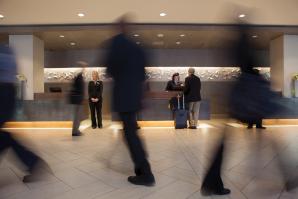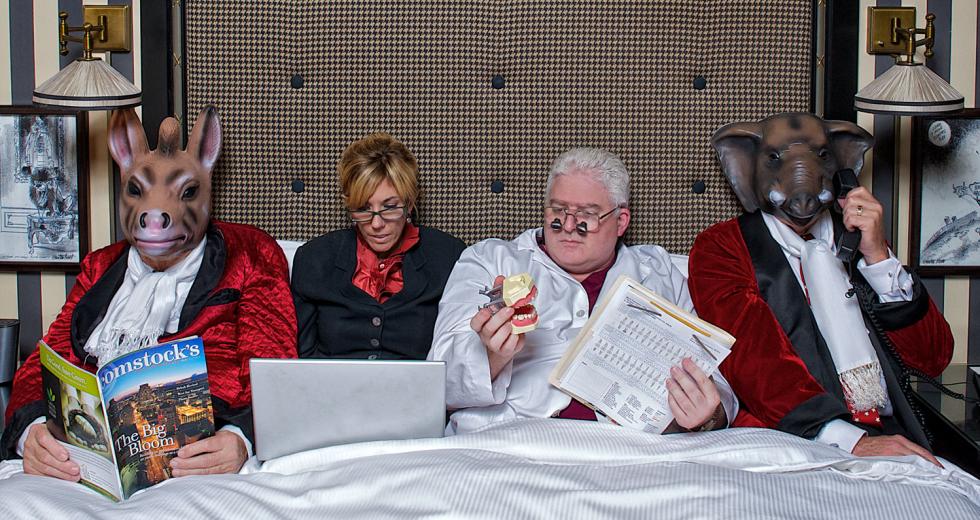State trade groups generate nearly $90 billion in annual spending nationwide through education and training programs, meeting products and services, and local, state and federal taxes, according to the California Society of Association Executives. Roughly 15 percent of that is spent right here in California, and much of it winds up in the till of the hospitality industry.
Sacramento corrals a hefty chunk of that expenditure since 60 percent of California-based association employees live in the Capital Region. They host their stakeholders here, hold their annual conventions here and encourage peer groups to visit. It means big money for our local hotels, restaurants, print shops, florists, entertainers, event planners and caterers, making the relationship between the two industries one of the most symbiotic in the region. But some say we could do a better job of attracting more business from the so-called capital cluster — lobbying groups, industry associations and political organizations.
Dave Butler, president of the nonprofit Linking Education & Economic Development, is one of them. He is challenging educators, the private sector and local government to develop a capital cluster in the same way the region has promoted green technology. If we do that, he says, numerous industries could be the beneficiary of a financial upswing, particularly hospitality.
“We host all these conventions, fly-ins, events and related businesses,” he says. “They’re basically all small enterprises that need office space, and they have payrolls and they all buy stuff, whether it’s paper or services or food. Yet we view the state government as an occupying force, not as any part of our economic engine. We have this disdainful view. We all like going to Washington, D.C., because it’s cool and exciting, but we are the Washington of the West Coast. Why don’t we embrace that? Why don’t we parlay that into more economic activity?”
The average association conference draws about 2,000 people, according to the executives association. On a three-year rolling average, they account for 24 percent of bookings for the convention bureau and approximately 34,300 room nights annually, according to Sonya Bradley, chief marketing officer at the Sacramento Convention & Visitors Bureau. In fiscal year 2009-2010, state associations and their 74,000 conference attendees accounted for $16 million of the bureau’s $128 million in convention sales.
In addition, according to the Office of the Secretary of State, lobbying firms spent roughly $737,000 a day last year getting their messages out at the Capitol — much of it was spent on meals and gifts purchased locally.
“When the Legislature is in session, there is a marked difference,” says Mark Mathews, general manager at The Citizen Hotel. “You feel it. Sacramento is also a unique market for (government) holidays, which have a huge impact here. If you were in any other city on Cesar Chavez Day, you wouldn’t be paying attention, but here we feel it; no one travels.”
April alone hosted a flurry of conferences in Sacramento, including The California Association of Health Facilities at the Hyatt Regency and the California Medical Association at the Sheraton Grand. The California Primary Care Association was in town, too, as were the pharmacists and the firefighters.
But who didn’t come? To name a few, the California WIC Association, based in Davis, held its annual conference in San Jose this past March. The National Business Incubation Association’s annual international conference was also in San Jose. Los Angeles nabbed the Sacramento-based California Dental Association; the Western Foodservice & Hospitality Expo, presented by the Sacramento-based California Restaurant Association, is in San Diego this year; and the California Cattlemen’s Association, also based in Sacramento, is holding it’s next midyear meeting in Sparks, Nev.
“We all like going to Washington, D.C., because it’s cool and exciting, but we are the Washington of the West Coast. Why don’t we embrace that?”
Dave Butler, president, Linking Education & Economic Development
“One of our regular practices is to look at the available dates within the Convention Center and then target convention groups that can fill those open dates,” said Mike Testa, vice president of communications and public affairs for the Sacramento Convention & Visitors Bureau, in an email. “But, even if we find a group that fits with the building’s availability, there’s no guarantee that the hotels will have the inventory to house them. In our business, it is an ever-changing equation, and there isn’t a typical pattern that we can count on with which to target new business because the bookings change from year to year. For any CVB, you work hard to keep your annual business annual and fill in the holes with whatever business you can generate on the open market.”
The bureau is studying a Convention Center expansion, according to Testa. If that happens, he says, “it would be relatively easy to make the argument for more rooms downtown.”
It’s difficult, he says, to put a finger on how many more rooms the market could handle since, during the recession, more rooms downtown could have had an adverse impact as hotels saw their overall occupancy numbers dwindle.
“On the other side of the recession, demand will increase, and if that demand surpasses the numbers we saw prerecession, the supply will need to increase, too,” he says. “There were a couple of developers, prerecession, who had hotel projects slated for downtown. That interest would not be there had their due diligence shown them that the market could not bear more rooms.”
Butler and others echoing his sentiment point to the economic activity already swirling around Sacramento: the natural, direct correlation between politics at the Capitol and the service industry surrounding it. If Sacramento can better understand the needs of both local and visiting cluster professionals, meet those needs and, at the same time produce a corps of local college graduates that will stay in town and grow the industry, there stands to be much gain.
Sacramento already has numerous attributes that work in its favor when marketing the city as a destination for political groups and associations. Its status as the capital of the eighth-largest economy in the world is an easy one to point to, plus there is close proximity to the airport, an up-and-coming food scene and plenty of recreation and entertainment options. Still, the battle for market share isn’t easily won.
“I think Sacramento is at a bit of a disadvantage because the political message is always ‘I’m going to go clean up Sacramento,’” Testa says. “So the marketing Sacramento gets in the election cycle is not good. The image it portrays to the rest of the state is often not very positive at all.”
And so goes the long-winded conversation about Sacramento’s identity crisis.
“I think we need to continue to establish an identity,” Mathews says. “It’s probably unrealistic to think that we are going to compete with a market like Atlanta or Orlando or Las Vegas; they have things we don’t and never will. But there are groups out there that can’t afford those big markets, so what is our cache?”
In recent years it’s been gold or, more specifically, the bureau’s Discover Gold campaign touting Sacramento as the home of gold rush-era attractions, Capitol tours, outdoor adventures and cultural arts. “When you visit Sacramento, you’re sure to Discover Gold!” the slogan reads. Solid, but not groundbreaking.
Our prime market competitor to the west, the San Jose Convention & Visitors Bureau (dubbed Team San Jose) with a $6 million budget, has just completed a rebranding campaign inclusive of a new tagline — Innovation Starts Here — logo and messaging “meant to revolve around San Jose’s two main differentiators as a destination: our unique organizational model and our location,” said Diana Ponton, vice president of sales and marketing for Team San Jose, via email. “Our tagline really speaks to the fact that San Jose is in the heart of Silicon Valley and home to top global innovators such as Adobe, Cisco and eBay.”
On average, state associations account for 12 percent of San Jose’s room nights sold annually, according to Ponton, translating to about 24,000 room nights in the city. For fiscal year 2009-2010, the market generated 55,000 convention attendees and more than $11 million in estimated visitor spending within San Jose. The annual economic impact totaled $85 million, Ponton says.
“Sometimes the hardest sell is to state association groups based here; they live here and may not be enamored by having their meetings locally.” —Sonya Bradley, chief marketing coordinator, Sacramento Convention & Visitors Bureau
For now, the Sacramento Convention & Visitors Bureau is spending its $5 million annual budget on what Bradley calls the big fish strategy.
“California state associations, 99 times out of 100, are going to meet in California,” Bradley says. “But sometimes the hardest sell is to state association groups based here; they live here and may not be enamored by having their meetings locally.” It’s for just that reason other cities, including Long Beach and San Jose, which are major competitors for this business, have their own sales directors based here in Sacramento.
“How do we make sure that our local associations understand that [Sacramento] is worthy of them bringing their delegates here?” Bradley says. “When you meet here, you are the big fish in the pond. You get good service. If you go to a Chicago or Atlanta with extremely large convention centers and much more space, you might not get the same attention.”
Still, while Sacramento may be able to offer the personal touches of a metro hub with small-town feel, many political groups and associations seeking an event locale are lured away by the bright lights of the big cities, relatively speaking.
To help lasso more of the groups doing business outside of Sacramento, Butler has proposed a loosely structured effort to identify the capital clusters’ work force needs and how the region’s colleges can address them. Butler’s nonprofit hosted a roundtable this year that drew employers and educators connected to the capital cluster.
“Our region’s No. 1 civic priority has got to be diversifying our economy, and that means identifying economic sectors core to our economy that we have an advantage in, that make money, that we can leverage and grow,” Butler says. As an example, he points to San Diego’s thriving biotech industry and the dominant biotech programs at UC San Diego.
“But if you look at Sacramento and public policy, Sacramento State is the driver, and I don’t think we leverage them enough as a leader in that space,” Butler says. “Sac State should be our Georgetown.”
Nearly every speaker on the LEED event panel — Testa; Ed Manning, principal at KP Public Affairs, one of the region’s largest lobbying firms; Dina Hidalgo, chief personnel officer for the State Senate; and Cassandra Walker Pye, a senior vice president in Apco Worldwide Inc.’s Sacramento office — voiced a pressing need for better equipped writers.
According to Walker Pye, top-tier writers are one of the capital clusters’ greatest needs. The others agreed.
“What (our universities) are lacking is a premier communications program where people not only learn about government affairs and politics but that really hones people’s writing skills, analytical ability and communications skills,” Manning says.
“If you want Sacramento to be on the map for this industry, we need more high-profile programs with degrees aimed at careers in public policy, politics and lobbying,” he says, citing the University of Southern California’s Annenberg School for Communication & Journalism as a prime example. “Second, you would draw in professionals to come in and teach, and third, you would have a relationship with the lobbying firms where you can place students. If that does exist, they sure haven’t been talking to us.”
Recommended For You

Survey Says
Sacramento hotels are doing something right
The latest hospitality survey by J.D. Power and Associates documents what many hotel travelers already know: Customer satisfaction with the nation’s hotels is slipping — substantially.

World Travel
Can Sacramento cash in on an influx of Chinese tourism dollars?
Two hundred million Chinese tourists will pack their bags and depart their homeland in 2020, bound for destinations across the globe. It’s not a mass exodus; they’re not fleeing their government. They’re tourists, and, according to CNN, they might be the greatest phenomenon to hit the global travel industry since the invention of commercial flight.



